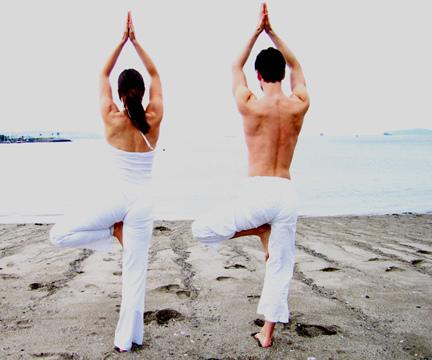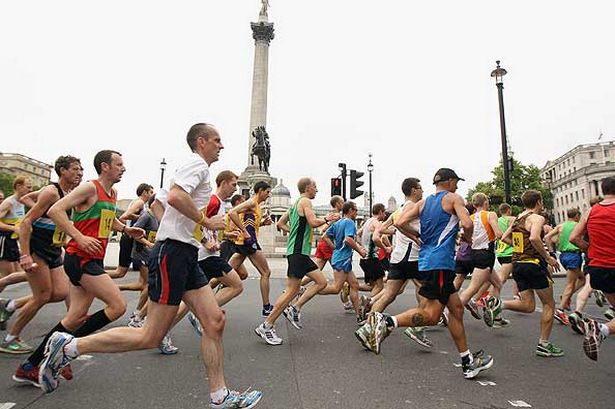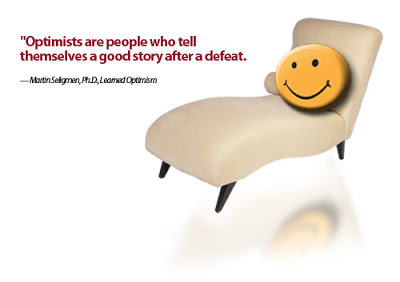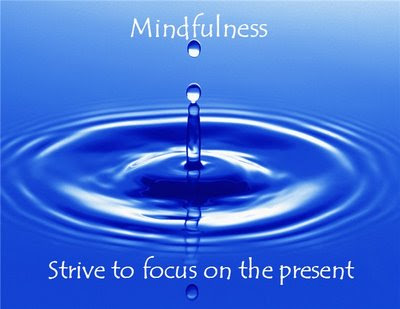Where your group creates its page(s)
Wiki
Social Not Solo Exercises
"No man is an island" - John Donne

Introduction
According to Ward and Stewart (2003), all human beings seek nine primary “goods” in their lives. Looking at this model, it seems obvious that some of these “goods” are more group based, such as friendship, community and excellence in play and work, whereas others are more individually focused, such as inner peace and healthy living, and excellence in agency. Interestingly others can be sought in both group and individual fashion, such as happiness, spirituality, knowledge and creativity. Here we will be discussing five exercises that can help us achieve some of these “goods” mentioned above. These are physical exercises, therapies, religion and gratitude and will compare their effectiveness and practicalities when they are experienced individually or in a group.
First we will be discussing that in general, physical activities can reduce stress. Additionally, if they are practiced socially, they can have secondary benefits that become apparent later on, such as improved relationships and the feeling of belonging to a social group. Then the importance of therapies will be discussed and how enhancing good attributes is just as important (if not more) as reducing negative symptoms. We will also discuss how religion and certain types of prayers specifically can produce self-fulfilling prophecies and that practicing it in a social group can reinforce this even further. Finally we will explain how gratitude, which is usually a more individually focused exercise can help self-awareness, and that it can also be beneficial in a group setting as the experience can be very rewarding and have long term benefits
Contents
History
Sport
Therapies
Religion
Gratitude
History
― Thich Nhat Hanh, Buddhist Monk
Yoga

Yoga is an ancient practice based upon discipline of the body, mind, and spirit. While there are many different forms of yoga, the overarching goal is for spiritual insight and tranquility. Pranayama believed to have been since around 1200-1500 BC in India used for spiritual enlightenment (“Yoga History”). Pranayama focuses primarily on controlling your breath and mediation, Prana in sandskrit means, “life force” or breath and “ayama” means to restrain or control (Hayes). Pranayama techniques are preformed both independently and in groups. Followers of the practice also are believed to develop a stronger will-power, sounder judgement, steadier mind, and an enhanced perception of the world around them (Hayes). Modernly Pranayama is used to help reduce a variety of serious medical conditions such as, hypertension, insomnia, stress, anxiety, and depression (Hayes). In fact, 14 million Americans participate in Yoga under their doctors recommendation (Yoga). Traditionally yoga was passed down from instructor to student through demonstration and orally teaching the lessons (“General”). Yoga and Pranayama practices are widespread throughout the world individuals often take group classes and then continue independently.
Prayer
No matter the religion, prayer is a religious practice that can be seen across almost all faiths. Prayer for the Ancient Greek and Romans was often during large public, ritualistic offerings. Animals and sometimes even humans would be sacrificed for the God’s favor. In Judaism and Christianity most prayer is individual except for that done on within each religions respective house of worship and on holidays. In recent years, prayer groups have become very common, giving individuals the opportunity to meet with others and support each other.
In most of the religions mentioned prayer is done to pray for the love of God, confession, help and guidance, as well as enlightenment.
Support Groups:
Group Psychotherapy: Started in the United States and in the United Kingdom in the early half of the 20th century. An early proponent of groupspsychotherapy, Irvn Yalom focused on interpersonal learning his work has been probably the most influential in the field (Wise 299).
From his research, Yalom developed a list of therapeutic factors which he believed created change within group therapy, these are (Yalom):

Universality: Sharing of experiences seeks to relieve feelings of isolation and promote self-esteem
Altruism: By supporting others, group members increase their own self-esteem, coping and communication skills
Instillation of Hope: Inspiring other group members through success
Imparting Information: Learning about others' treatment and their experience as support
Corrective recapitulation of the primary family experience: Similar to the idea of transference, individuals identify therapist or other members as own family members and can have a better understanding of their own past and patterns
Development of socializing techniques: Through interaction within the supporting environment of the group
Imitative behavior: Modeling actions on the therapist and other group members
Cohesiveness: Sense of acceptance, belonging, and self-esteem from being a member of a group
Existential factors: Learning personal responsibility and consequences of actions
Catharsis: Relief from emotional distress through group discussion
Interpersonal learning: From feedback from therapist and other group members
Self-understanding: Greater insight into oneself
These themes pull from older findings and his own research and can be seen today in support groups.
Whether one type of exercise, be it social or solo, has not been determined. The prevalence of both in history and more modernly suggests that it is not a black and white decision. Rather, the choice is dependent on the particular exercise, individual, and situation.
References
"General Yoga Information." Welcome to The American Yoga Association. Web. 30 Jan. 2012. <http://www.americanyogaassociation.org/general.html>.
Hayes, M. & Chase S. (2010). Prescribing Yoga. Primary Care: Clinics in Office Practice. 37 (1), 31-47.
Wise, J. (2009). Book essays and reviews. Psychodynamic group psychotherapy, fourth edition. Psychiatry: Interpersonal & Biological Processes, 72(3), 299-302.
Yalom, Irvin D. The Theory and Practice of Group Psychotherapy. New York: Basic, 1985. Print.
Yoga. (2009). SGB, 42(3), 62-62. Retrieved from http://ezproxy.lib.uconn.edu/login?url=http://search.proquest.com/docview/223574659?accountid=14518.
"Yoga History." The Interactive Media Lab at the University of Florida. University of Florida. Web. 30 Jan. 2012. <http://iml.jou.ufl.edu/projects/fall05/levy/history.html>.
Sport:
"Sport has the power to change the world. It has the
power to unite in a way that little else does. It speaks to youth in a language
they understand. Sport can create hope where once there was only despair. It is
more powerful than governments in breaking down racial barriers. It laughs in
Within the domain of positive psychology there are countless theories, beliefs and ideas that have been developed with one aim in mind, to increase our mental well-being. In this section of solo vs. social we will compare and contrast just some of the individual and group exercises and sports, in order to see the benefits elicited by each. There are many who use physical activity in either individual or social settings, yet it is not fully known if the positive effects are augmented more in a group dynamic, or if they are best done by one’s self. We will therefore evaluate solo exercises with social exercises to see just what is best in the realms of positive psychology.

Solo Exercise: Walking
‘I have met with but one or two persons in the course of my life who understood the art of taking walks daily – not to exercise the legs or body merely, nor barely to recruit the spirits, but positively to exercise both body and spirit, and to succeed to the highest worthiest ends by abandonment of all specific ends – who had a genius, so to speak, for sauntering’ (Thoreau, 1851/1952 p. 192)
There are literally dozens of solo exercises that are utilised within the field of positive psychology as effective activities for increasing mental well-being. In the interest of this section however we will look at how walking and running are increasingly being prescribed as effective treatments for numerous mental illnesses, such as, depression, anxiety and schizophrenia (Stephens, 1988; Weyerer, 1992; Hassme´n et al., 2000). Although walking and running are not strictly solo exercises they can be done individually and do not require any other people, so what are the benefits? Exercise has a myriad of effects on the mind and body, from relieving stress to producing endorphins there is simply a catalogue of positive effects to be found. It is amongst the most popular recreational activity for both males and females (UK Bureau of statistics, 2009), and therefore is regarded as very assessable.
Walking is a fantastic anaerobic exercise that simply more people should engage in. It is said to provide introspection as our mind wonders as we gasp for air, allowing us to will away the troubles of everyday life. A study which illustrate just how effective walking can be on our well-being is Discover Quest, a community based project in the UK (Hine, Wood, Barton and Pretty, 2011). The program provides a fantastic opportunity to adults whose mental health is having a significant impact on the way they are managing their lives. The study utilizes the Warwick Edinburgh Mental Well Being Scale (WEMWBS), which evaluates well-being, mood and self-esteem. Through a multi-method approach data was collected through questionnaires, on site observation and interviews with researchers. The results highlighted changes in all three well-being measures, with significant improvements recorded in each. Overall 89% of subjects noted an increase in general well-being. This study is proof of how a solo exercise like walking can have an overall positive effect on one’s life and well-being.
Social Exercise – Group Exercise Classes and Walking
We have seen the benefits of solo exercises, but these tasks done as part of a group or team dynamic can have a whole range of different effects. There is increasing evidence to suggest that people who participate in sports clubs and organisations enjoy better mental health, are more alert, and more resilient against the stresses and strains of modern life (Marmot, 1999; Baum et al., 2000; Crone, Smith & Gough, 2005; Kwak, Kremers, Walsh & Brug, 2006). The distinction between solo and social exercises is this feeling of value and belonging which is associated with team activities (Berkman, Glass, Brissette, Seeman, 2000).
There have been numerous studies which have documented the benefits of social interaction and mental well-being (Kwak, Kremers, Walsh & Brug, 2006; Dalgard, Lund Haheim, 1998). This link was emphasised in the Whitehall study in the United Kingdom were the results found that people without good social support were five times more likely to develop a mental illness than those with good support (Marmot, 1999). The benefit from a strong social group is its ability to help dealing with stressful life situations (Dalgard & Haheim, 1998), the Mayo Clinic, Minnesota, USA, advocates joining a group or club in order to buffer against the effects of stress. Not only are the effects likely to help prevent stress there is good evidence to suggest that they are proficient in maintaining good mental health (McAuley et al., 2005: Steptoe & Butler, 1972; Brown, Ford, Burton, Marshall & Dobson, 2005).
This buffer against mental illnesses has been uncovered in a number of recent studies. For instance Babyak et al., (2000) took a sample of 156 adults with major depressive disorders in North Carolina; they were assigned to one of three experimental groups (treatment by medication, exercise or both). The study utilised Beck’s Depression Inventory and was able to show that after 4 months all three groups exhibited significantly less depression. And even more surprisingly after 10 months subjects in the exercise group exhibited lower relapse rates. The results provide conclusive proof of the effectiveness of a modest exercise program for individuals that suffer from a major depressive disorder.
Conclusion
Group exercise has the power to unite people and provide group cohesion. As we identified in the solo section walking does have the ability to increase one’s general well-being and promote better lifestyles, but it does lack a lot of the benefits associated with social exercise. This is well illustrated in the National Heart Foundation’s research of their ‘Just walk it’ program, as they identify the main predictor of adherence to the project as social collaboration. They state it as vital component of their work and is necessary for creating positive attitudes towards physical exercise (Kwak, Kremers, Walsh & Brug, 2006). There appears to be greater reward from group work rather than enduring exercise on your own. Although the benefits from exercise are very well received, the use of participating in a team or club can provide a whole host of positive aspects that could not be achieved by doing it solo. From promoting group attitudes and norms, to feeling part of a collective whole, exercising with others appears to be more effective in uniting one another to strive towards greater a better life, with increased well-being.
References
Babyak, M et al., (2000). Exercise Treatment for Major Depression: Maintenance of Therapeutic Benefit at 10 Months. Psychosomatic Medicine 62:633– 638 (2000)
Hine, R. Wood, C. Barton, J. Pretty, J. (2011).The mental health and wellbeing effects of a walking and outdoor activity based therapy project. Discovery Quest report -University of Essex
Palmer LK. 1995. Effects of a walking program on attributional style, depression and self esteem in women. Perceptual and Motor skills, 81, 891-898
Street, G. James, R. (2010). The Relationship between Organized Recreational Activity and Mental Health: Mentally Healthy WA Centre for Behavioural Research in Cancer Control, Curtin University
Mayo Clinic staff. Get involved: A healthy habit for healthy aging. In. Rochester: Mayo Foundation for Medical Education and Research; 2003.
Therapies
Little progress can be made by merely attempting to repress what is evil; our great hope lies in developing what is good--Calvin Coolidge
Psychotherapies generally lead to symptom reduction, and many psychologists believe that once the negative symptoms are dealt with, the positive traits will automatically replace them. However most “successful” therapies that are usually problem-focused for treating offenders have still ended up with high rate of recidivism, suggesting that interventions also need to focus on enhancing strengths and good attributes if they are going to have long-term benefits.
Some researchers have suggested that group therapy involves different processes as well as different therapeutic factors than individual therapy (Bednar & Kaul, 1994) Bietzel et al. (1987) suggested that individual therapy tended to be more effective for treating depression, whereas group therapy has been shown to be effective for treating clients with chemical dependency problems. However not many studies have examined the difference between individual versus group positive themed therapies.
Positive Psychotherapy (PPT)

Seligman et al developed positive psychotherapy as a way to treat depression by building positive emotions, character strengths, and sense of meaning, not just by reducing negative symptoms such as sadness. This therapy uses a combination of 12 exercises such as assessing strengths and to use them in a new way, writing down three good things everyday and thinking why they happened, writing a thank you letter to a friend, reacting positively to someone once a day, mindfulness exercises etc.
To see if individual and group based PPTs differ from one another, Seligman et al (2006) compared different types of PPTs, one group based and one individual based and found that both types of PPTs showed significant reduction in depressive symptoms than treatment as usual groups. This effect size for both groups was moderate to large and in the group condition, it lasted for up to 1 year, suggesting that even in the group PPT, important self-maintaining factors are imbedded in the exercises. However In a study by Goodwin et al (2011), they provided 10 weeks of group PPT to stressed and anxious individuals to see whether it improved their relationship satisfaction. They found no overall significant improvement in their relationships, but PPT significantly reduced their level of anxiety and stress.
Well-Being Therapy (WBT)

WBT is based on Ryff's multidimensional model of psychological well-being, encompassing environmental mastery, personal growth, purpose in life, autonomy, self-acceptance and positive relations with others. The patient keeps a journal to keep track of and recognise the positive events that occur each day. Next the patient starts recognising negative thoughts and beliefs that distract from or disrupt positive events. The ultimate goal is to challenge and eventually change negative ways of thinking, to enable positive events to have more of an impact on the patient’s life.
The research on the clinical application of WBT is in its infancy (Fava, 1999), and there has not beet much research on the difference between group versus individual based WBTs. However the current research seems to particularly show support for group WBT. For example Feldman et al (2006) developed a hope-based group intervention and showed individuals who completed this intervention reported increased life meaning, self-esteem and reduced anxiety and depression. Also it was shown that young offenders that received group WBT reported higher levels of well-being two months after they completed their treatments, and experienced improvement on a number of psychological variables, such as hopelessness, positive future thinking, depression and negative symptoms of psychosis (Ferguson et al, 2009). Furthermore research has shown that WBT appears to be more effective as compared to the standard CBT technique (Moeenizadeh and Salagame, in press) and CBT + WBT treatment is more effective in reducing negative symptoms and improving general well-being than CBT alone (Fava, et al). Also MacLeod, Coates, and Hetherton (2008) developed an intervention focused on developing goal setting and planning skills in a community sample. Individuals taking part in the intervention, both individually and in groups, showed significant increases in subjective well-being compared to controls.
Mindfulness-based cognitive therapy (MBCT) and Mindfulness-Stress Reduction Therapy (MBSR)
The proper function of man is to live, not to exist. I shall not waste my days in trying to prolong them. I shall use my time--Jack London

Mindfulness has roots in Buddhist and other contemplative traditions where conscious attention and awareness are actively cultivated. Mindfulness has been defined as ‘the awareness that emerges through paying attention on purpose, in the present moment, and non-judgementally to the unfolding of experience moment by moment’ (Kabat-Zinn, 2003)
Mindfulness-based cognitive therapy (MBCT) which incorporates mindfulness in an attempt to change an individual’s awareness of, and relationship to, unwanted thoughts and feelings, has also been found to prevent relapse in recurrent depression (Teasdale et al. 2000). The MBCT is usually administrated individually rather than in a group and it has shown to be effective in reducing chronic pain, anxiety disorders, substance abuse, insomnia, and anger management (Baer, 2003; Grossman et al. 2004). Also other mindfulness related therapies such Mindfulness stress reduction therapy (MBSR) which are always taught as a group intervention have shown promising results. For example, Imel et al (2008) have found that MBSR effectively reduced negative psychological symptoms and group membership was responsible for 7% of variability in this reduction, suggesting that social aspects of the therapy are important factors.
Conclusion
So far it seems inconclusive whether individual based therapies are superior or the group based therapies, although it seems that there is some social aspects of group based therapies can be beneficial. Also it is reasonable to suggest that group therapies are generally more cost effective and might have secondary benefits (such as friendship, improved social network, social exercises etc). However recent research has shown that even blogging (which is free) can act as some form of self-therapy (Tan, 2008). It appears that most therapies that are based on positive psychology tend to be more individual focused and therefore there is not much research on the difference of effectiveness of group vs individual based therapies specifically. However it is reasonable to suggest that perhaps there is not much of a difference after all and if there is any, we can not find out at the moment as the research is still in its infancy and there is a need for more research on specific types of therapies that focus on different populations and disorders.
There is no way to happiness, happiness is the way -- Thich Nhat Hanh
References
Ferguson, G., Conway, C., & Endersby, L. (2009). Journal of Forensic Psychiatry & Increasing subjective well- being in long-term forensic rehabilitation : evaluation of well-being therapy. Journal of Forensic Psychiatry, (February 2012), 37-41.
Khodayarifard, M., Shokoohi-yekta, M., & Hamot, G. E. (2010). International Journal of Offender Therapy and Comparative Criminology Therapy for Male. October. doi:10.1177/0306624X09344840
Seligman, M. E. P., Rashid, T., & Parks, A. C. (2006). Positive psychotherapy. American Psychologist, 61.(8), 774. American Psychological Association. Retrieved from <http://psycnet.apa.org/journals/amp/61/8/774/>.
Mazzucchelli, T. G., Rees, C. S., & Kane, R. T. (2009). Group behavioural activation and mindfulness therapy for the well-being of non-clinical adults: a preliminary open trial. The Cognitive Behaviour Therapist, 2(04), 256–271. Cambridge Univ Press. doi:10.1017/S1754470X09990201
Mcroberts, C., Burlingame, G. M., & Hoag, M. J. (1998). Comparative Efficacy of Individual and Group Psychotherapy : A Meta-Analytic Perspective. Practice, 2(2), 101-117.
Moeenizadeh, M., & Salagame, K. K. (2010). The Impact of Well-Being Therapy on Symptoms of Depression. International Journal of Psychological Studies, 2(2), p223. Retrieved from <http://ccsenet.org/journal/index.php/ijps/article/download/7030/6381>.
Fava, G. A., Ruini, C., Rafanelli, C., Finos, L., Salmaso, L., Mangelli, L., & Sirigatti, S. (2004). Well-being therapy of generalized anxiety disorder. Psychotherapy and psychosomatics, 74(1), 26–30. Karger Publishers. doi:10.1002/jclp
Grossman, P., Niemann, L., Schmidt, S., & Walach, H. (2004). Mindfulness-based stress reduction and health benefits: A meta-analysis. Journal of Psychomatic Research, 57, 35-43.
Imel, Z., Baldwin S., Bonus K., Maccoon D., (2008) Beyond the individual: Group effects in mindfulness-based stress reduction, Psychotherapy Research, 18 (6), 735-742
Tan, L., (2008) Psychotherapy: My Space blogging as self-therapy. American Journal of Psychotherapy, 62 (2)
Religion
“Spirituality and religiousness refer to beliefs and practices that are ground in the conviction that there is a transcendent (nonphysical) dimension of life. These beliefs are persuasive, pervasive and stable. They inform the kinds of attributions that people make, the meanings they construct and the ways they conduct relationships”. Peterson, C., & Seligman, M. E. P. (2004).
A character strengths and virtues classification guide (CSV) devised by (Peterson & Seligman, 2004) describes and classifies strengths and virtues that enable human thriving. Religiousness was identified as a character strength which contributes to the virtue of transcendence.
Religion & Happiness
There is an extensive literature on the effects of religion upon personal wellbeing, a review by Koenig, McCullough and Larson (2001) reported that religion has positive effects on mental and physical health. In this line, Lehrer (2004, as cited in Snoep, 2008) recently wrote that:
“There is considerable evidence that religion makes a difference to people’s lives: it provides social networks, favorably affects physical and mental health, school attendance and reduces deviant activity.’’
Therefore, it is argued that religiousness may be protective of psychological and physical wellbeing. Further still, religion may promote recovery from illness and aid in the prevention of morbidity and mortality (Koenig et al., 2001). In terms of physical health, research has shown that religiosity is associated with less coronary artery disease, hypertension, stroke, immune system dysfunction, cancer, functional disability or impairment, lower cholesterol level, greater longevity and fewer negative health behaviors, e.g., smoking, drug/ alcohol abuse, risky sexual behaviors, and sedentary lifestyle (Koenig, McCullough, and Larson, 2001). Similarly, Levin and Chatters (1998) found a positive association between religiosity and subjective health, and a negative link with physical symptomatology and dementia.
In terms of psychological health, research has found that religiosity may potentially prevent, buffer, or repair the effects of stress and anxiety (Kennedy, 1998; Abdel-Khalek, 2002). Religious and spiritual coping strategies were related to better mental health and faster adaptation to stress (Koenig et al., 2001). The higher the spiritual well-being, existential well-being and religious well-being were among males, the lower the anxiety (Davis, Kerr and Kurpius, 2003). Likewise, a significant negative relationship between religiosity and trait anxiety has been found (Harris, Schoneman and Carrera, 2002). A review by Koenig et al (2001) reported that the vast majority of studies, found religious involvement to be positively correlated with greater well-being (Koenig et al., 2001). Furthermore, a positive association has been found between religiosity and life satisfaction, happiness, emotional adjustment, self-esteem, mastery, physical/mental health and coping, whereas, religiosity was significantly and negatively correlated with anxiety and depression (Khaleck, 2007). With regards to happiness, numerous empirical studies have found that there is a cross-denominational correlation between religiousness and happiness (Blazer & Palmore, 1976; Hadaway, 1978; Moberg, 1979; Francis, Robbins and White, 2003; Khaleck, 2006).
But what aspects of religion produce happiness? Is it the social or solo practice of religion?
Specifically, research has shown that happiness is associated with the frequency of attendance at religious services, denominational preference and doctrinal preference (Ferris, 2002). Across religions and measures, congregational support and the public practice of religion appears to correlate with measures of life satisfaction for followers (Cohen, 2002). The correlation between religiousness and happiness is attributed to the positive functions of religion, such as providing meaning and social support (Snoep, 2008). Involvement within a religious community and attendance at services is consistently associated to lower mortality and greater longevity (Koenig et al., 2001). An international investigation across three countries (USA, Netherlands and Denmark) reported that the social aspects of religion rather than the private experience of religion contributed more to happiness. Church participation was found to be more beneficial to wellbeing than prayer, meditation and belief in God. Time spend with people at church appeared to be the strongest predictor of happiness in the USA and belonging to a church organization the most important factor in Denmark and the Netherlands (Snoep, 2008). Church membership may increase happiness by providing a mechanism for social support, provide a purpose in life, provide hope and the social experience of religious practice may make individuals more happy. However, research has also found that church attendance does not correlate with happiness scores (Ellison, Gay, & Glass, 1989; Seligman, 1988; Soloman, Greenberg, & Pyszczynski, 1991; Hay, 1982).
Prayer

A fundamental religious practice is prayer.
Research has proposed that the frequency of prayer is a dominant factor in the relationship between religiosity and psychological well-being. Furthermore, personal prayer may be an important variable to consider within the theory of religious coping (Maltby, Lewis, and Day, 1999). Row and Elliot (2009), reported that prayer significantly contributed to psychological and subjective wellbeing. Conversely, it has been suggested that prayer does not contribute towards wellbeing and prayer frequency is a poor predictor of happiness and functioning (Masters, 2007; Rosmarin 2009). What is more, people who are happier do not pray as frequently as those with lower happiness levels, thus, it appears that the type of prayer may be more important (Polloma and Pendleton, 1989). It has been found that meditative prayer is related to an increased quality of life, existential wellbeing and religious satisfaction. However, petitionary prayer (asking for material things) does not benefit wellbeing. Colloquial prayer (asking for benevolent things) is the only form of prayer which influences happiness, whereas, ritual prayer influences negative affect (Polloma and Pendleton 1989).
The Dark Side of Religion
However, contrasting research has reported that there may be a negative link between religion and wellbeing. Recent research has found no significant relationship between religiosity and happiness (Lewis, Maltby and Burkinshaw, 2000, Lewis, Maltby and Day, 2005; Francis, 2003). Religiosity is positively associated with anxiety, depression, intolerance of ambiguity and rigidity. Moreover, it is associated with authoritarianism, prejudice, dependency, poor physical and mental health, fear of death, guilt and social conflict (Koenig et al., 2001; Pressman., et al 1992; Hood, 1992). Therefore, religion may also be associated with unhappiness (Lewis, 2006).
References
Abdel-Khalek, A. M. (2002). Age and sex differences for anxiety in relation to family size, birth order, and religiosity among Kuwaiti adolescents. Psychological Reports, 90, 1031–1036.
Ahmed M. Abdel-Khalek (2006): Happiness, health, and religiosity: Significant relations, Mental Health, Religion & Culture, 9:1, 85-97
Ahmed M. Abdel-Khalek (2007): Religiosity, happiness, health, and psychopathology in a probability sample of Muslim adolescents, Mental Health, Religion & Culture, 10:6, 571-583
Blazer, D., & Palmore, E. B. (1976). Religion and aging. Gerontologist, 16, 82–85.
Cohen, A. B. (2002). The importance of spirituality in well-being for Jews and Christians.
Davis, T. L., Kerr, B. A., & Kurpius, S. E. (2003). Meaning, purpose, and religiosity in at-risk youth: The relationship between anxiety and spirituality. Journal of Psychology and Theology, 31, 356–365.
Ferriss, A. L. (2002). Religion and the Quality of Life. Journal Of Happiness Studies, 3(3), 199-215.
Francis, L. (2003). The Relationship Between Religion and Happiness Among German Students. Pastoral Psychology, 51(4), 273-281.
Francis, L. J., Robbins, M., & White, A. (2003). Correlation between religion and happiness: A replication. Psychological Reports, 92(1), 51-52. doi:10.2466/PR0.92.1.51-52
Hadaway, C. K. (1978). Life Satisfaction and Religion. Social Forces, 57, 636–643.
Happiness Studies, 3, 287–310.
Harris, J. I., Schoneman, S. W., & Carrera, S. R. (2002). Approaches to religiosity related to anxiety among college students. Mental Health, Religion and Culture, 5, 253–265.
Kennedy, G. J. (1998). Religion and depression. In H. G. Koenig (Ed.), Handbook of religion and mental health (pp. 129–145). San Diego: Academic Press.
Koenig, H. G., McCullough, M. E., & Larson, D. B. (2001). Handbook of religion and health Oxford: University Press.
Levin, J. S., & Chatters, L. M. (1998). Research on religion and mental health: An overview of empirical findings and theoretical issues. In H. G. Koenig (Ed.), Handbook of religion and mental health (pp. 33–50). New York: Academic Press.
Lewis, C. (2002). Church Attendance and Happiness Among Northern Irish Undergraduate Students: No Association. Pastoral Psychology, 50(3), 191-195.
Gratitude: Both Social & Solo
The most common definition of gratitude is being thankful or appreciative for a gift or favor, but gratitude can also mean counting your blessings and regarding simple pleasures. Being continually grateful means being continually aware of how much you have been given and treating everything as a miracle. Psychological research, specifically in the field of positive psychology, have indicated that life improvements result from the practice of feeling gratitude. These life improvements include becoming happier, more resilient, alleviating stress, strengthening relationships, and improving health. Once one maintains the habit of looking for things to be grateful for, you appreciate simple pleasures and things you previously took for granted. Then gratitude is not just a reaction to receiving what you want, but a consistent, continual gratitude.
Experimental Evidence: Solo
A number of studies have been carried out to see if there are effects on one’s happiness and well-being with the practice of giving and feeling gratitude. Two psychologists, Michael McCollough of Southern Methodist University in Dallas, Texas, and Robert Emmons of the University of California at Davis conducted an experiment to observe the impact of gratitude on well-being. Several hundred people were split into three different groups and all asked to keep daily diaries. The first group was asked to write about either good or bad things that occurred through out the day, the second was asked to record unpleasant experiences, and the third was asked to make a list of things for which they were grateful. The results indicated that the third group showed higher levels of reported alertness, enthusiasm, determination, optimism, and energy. The gratitude group also experienced less depression and stress, more willing to help others, exercise more, and made more progress towards achieving personal goals. These people showed the best positive affects of all the groups (Emmons and McCollough, 2003). This study and others like it conclude that a conscious focus on blessings may have emotional and interpersonal benefits.
From his studies, Dr. Emmons has concluded that we all have a basic level of happiness that is set at a predetermined point. If something unpleasant happens, one’s happiness drops momentarily and then will return to your natural level. He argues that a practice of gratitude raises your “happiness set point” so you can maintain a higher level of happiness no matter the circumstances. This results in better well-being and appreciating all experiences (Emmons and McCollough, 2003).
Social
While Emmons and McCollough’s study shows the benefits for individual exercises of gratitude, there are also merits for one’s well being in practicing gratitude exercises socially and interpersonally. Two studies performed by Bartlett et al. found evidence that links gratitude to increases in relationship satisfaction. While it is not entirely clear how gratitude does this, there is a correlation made. Study 1 provided evidence that gratitude promotes social affiliation which leads to one choosing to spend time with another and study 2 showed that gratitude can further strengthen relationships. The studies indicated that gratitude facilitates socially inclusive behaviors, even when the behaviors come at a cost to oneself (Bartlett et. al., 2012). The common conclusion among studies that observe the social benefits of gratitude say that these exercises make people feel connected to others. They give people a sense of purpose because they matter to others.
Exercises
There are many ways to boost one’s happiness and well-being. Some exercises are practiced in the personal space, at the individual level, while others can be practiced among others, at the social level. In the article, The New Science of Happiness by Claudia Wallis, Dr. Martin Seligman’s exercises of gratitude are referenced as one method for increasing happiness and physical and emotional well being. Among others, he dictates two exercises of giving gratitude that are said the increase one’s happiness (Wallis, 2005).
Solo
The first he refers to as “Three Blessings” or “Gratitude Journal Exercise”. This entails the individual recording at least three things that went well each day. Seligman argues that putting into words your gratitude, one increases their appreciation and memory of their blessings. He found that when the exercise becomes habitual, it tends to increase happiness and lower depression (Wallis, 2005). This exercise is at the individual and personal level, and does not call for interaction with others. This solo practice is similar to Emmon and McCullough’s study, in that one’s happiness and well being will increase, both physically and emotionally. Seligman found that “Three Blessings” is a less powerful, but more lasting exercise in producing happiness, than the “Gratitude Letter”.

Social
The other practice he calls a “Gratitude Letter” or “Visit Exercise”. This calls for the individual to think of someone who has contributed to their well-being and whom then have never fully thanked. They write a letter to that person describing the benefits received from them and how those actions made them feel. They then deliver this letter to that person (Wallis, 2005). This is an example of a social gratitude exercise because the individual feeling the gratitude is sharing the experience with another person and allowing the practice of gratitude to be witnessed. As seen in Bartlett et al.’s studies, this practice would strengthen the relationship the person has with another individual.
When Applicable?
The practices of recording and expressing gratitude have been seen in many forms. Seligman concluded that gratitude not only lifted one’s mood, but also improved physical health, increased energy levels, and decreased the pain and fatigue in those with neuromuscular disease (Wallis, 2005). Both the practices of giving gratitude at the individual and social levels, have been found useful in counseling psychology. Asking a subject to record or express gratitude can inform individual strategies for well being improvement and can contribute to the development of more sustained programs of intervention (Nelson, 2009). In general, gratitude improves well being as a means of buffering against negative states and emotions, while forming the habit to acknowledge simple pleasures and gifts received.
Suggested Readings
Seligman, Dr. Martin. 2002. Authentic Happiness. New York, NY: The Free Press.
Bartlett, Monica Y.; Condon, Paul; Cruz, Jourdan; Baumann, Jolie; Desteno, David. January 2012. Gratitude: Prompting behaviors that build relationships. Cognition & Emotion. Vol. 26 Issue 1, p2-13, 12p
Emmons, R. A., & Mc Cullough, M. E. (2003). 'Counting blessings versus burdens: An experimental investigation of gratitude and subjective well-being in daily life.' Journal of Personality and Social Psychology. 84. 377–389.
Nelson, Catherine. Nov 2009. Appreciating gratitude: Can gratitude be used as a psychoogical intervention to improve individual well-being? Counselling Psychology Review, Vol 24(3-4). pp. 38-50.
Wallis, Claudia. Jan. 09, 2005. The New Science of Happiness. TIME Magazine.
References
Lewis, C. (2006). Religion and happiness: Consensus, contradictions, comments and concerns. Mental Health, Religion & Culture, 9(3), 213-225.
Lewis, C., Maltby, J., & Day, L. (2005). Religious orientation, religious coping and happiness among UK adults. Personality And Individual Differences, 38(5), 1193-1202.
Maltby, J., Lewis, C., & Day, L. (1999). Religious orientation and psychological well-being: The role of the frequency of personal prayer. British Journal Of Health Psychology, 4(Part 4), 363-378
Masters, K. (2007). Prayer and Health: Review, Meta-Analysis, and Research Agenda. Journal Of Behavioral Medicine, 30(4), 329-338.
Moberg, D. O. (Ed.). (1979). Spiritual Well-Being. Washington. D.C.: University Press of America.
Peterson, C., & Seligman, M. E. P. (2004). Character strengths and virtues: A handbook and classification. Washington, DC: American Psychological Association.
Seligman, M. E. P. (1998). Optimism, hope, and ending the epidemic of depression. Address given at the John Templeton Foundation Board of Advisors meeting. Philadelphia, February 10.
Seligman, M.E.P.; Steen, T.A.; Park, N.; Peterson, C. (2005). Positive Psychology Progress: Empirical Validation of Interventions. American Psychologist, Vol 60(5), 410-421.
Snoep, L. (2008). Religiousness and happiness in three nations: a research note. Journal Of Happiness Studies, 9(2), 207-211.
Lewis, A.C. Maltby, J. Burkinshaw, S. (2000). Religion and happiness:Still no association. Journal of Belief & Values: Stuides in Religiona and Education, vol 21 (2), 233-236.


 Moodle Docs for this page
Moodle Docs for this page